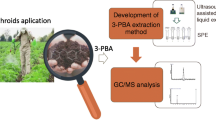Abstract
A rapid, simple, sensitive and cost-effective analytical method has been standardised to determine the residues of imidacloprid and thiamethoxam in soil. This method does not require any cleanup with costly sorbents. The recoveries of imidacloprid and thiamethoxam obtained in this no-cleanup method were on par with the protocol involving primary–secondary amine-based cleanup. This method requires less volume of solvent (20 mL of acetonitrile/sample) and is suitable for high throughput analyses involving large number of samples. The limit of quantification of the method was 0.01 μg/g. Dissipation kinetics of imidacloprid and thiamethoxam in the soils of sugarcane ecosystem was studied by adopting this rapid method. The half-life of imidacloprid and thiamethoxam was 9.07 and 6.22 days when applied at 70 and 100 g a.i./ha, respectively. The dissipation of both the neonicotinoids followed first-order kinetics with good fit.



Similar content being viewed by others
References
Arora, P. K., Jyot, G., Singh, B., Battu, R. S., Singh, B., & Aulakh, P. S. (2009). Persistence of imidacloprid on grape leaves, grape berries and soil. Bulletin of Environmental Contamination and Toxicology, 82, 239–242.
Barik, S. R., Ganguly, P., Kunda, S. K., Kole, R. K., & Bhattacharyya, A. (2010). Persistence behaviour of thiamethoxam and lambda cyhalothrin in transplanted paddy. Bulletin of Environmental Contamination and Toxicology, 85, 419–422.
Central Insecticide Board & Registration Committee. (2009). Major uses of pesticides registered under the Insecticides Act, 1968. http://www.cibrc.nic.in/mupi.pdf. Accessed 25 May 2012.
Directorate of Sugarcane Development. (2012). Major insect pest management of sugarcane crop. http://dsd.dacnet.nic.in/PestManage.htm. Accessed 25 May 2012.
European Commission. (2010). Guidance document on pesticide residue analytical methods. Document No. SANCO/825/00/rev. 8.1/16/11/2010. http://ec.europa.eu/food/plant/protection/resources/guide_doc_825-00_rev7_en.pdf. Accessed 25 May 2012.
Gupta, S., Gajbhiye, V. T., & Gupta, R. K. (2008). Soil dissipation and leaching behaviour of a neonicotinoid insecticide thiamethoxam. Bulletin of Environmental Contamination and Toxicology, 80, 431–437.
Kanrar, B., Ghosh, T., Pramanik, S. K., Dutta, S., Bhattacharyya, A., & Dhuri, A. V. (2006). Degradation dynamics and persistence of imidacloprid in a rice ecosystem under West Bengal climatic conditions. Bulletin of Environmental Contamination and Toxicology, 77, 631–637.
Karmakar, R., Singh, S. B., & Kulshrestha, G. (2006). Persistence and transformation of thiamethoxam, a neonicotinoid insecticide, in soil of different agro-climatic zones of India. Bulletin of Environmental Contamination and Toxicology, 76, 400–406.
Karmakar, R., Singh, S. B., & Kulshrestha, G. (2012). Water based microwave assisted extraction of thiamethoxam residues from vegetables and soil for determination by HPLC. Bulletin of Environmental Contamination and Toxicology, 88, 119–123.
Kumar, R., & Dikshit, A. K. (2001). Assessment of imidacloprid in Brassica environment. Journal of Environmental Science and Health, Part B: Pesticides, Food Contaminants, and Agricultural Wastes, 36(5), 619–629.
Maienfisch, P., Huerlimann, H., Rindlisbacher, A., Gsell, L., Dettwiler, H., Haettenschwiler, J., et al. (2001). The discovery of thiamethoxam: a second-generation neonicotinoid. Pest Management Science, 57(2), 165–176.
Nauen, R., Ebbinghaus-Kintscher, U., Salgado, V. L., & Kaussmann, M. (2003). Thiamethoxam is a neonicotinoid precursor converted to clothianidin in insects and plants. Pesticide Biochemistry and Physiology, 76, 55–69.
Samnani, P., Vishwakarma, K., & Pandey, S. Y. (2011). Simple and sensitive method for determination of imidacloprid residue in soil and water by HPLC. Bulletin of Environmental Contamination and Toxicology, 86, 554–558.
Solomon, S. (2011). The Indian sugar industry: an overview. Sugar Tech, 13(4), 255–265.
Acknowledgments
The authors express their gratitude to Dr. N.V. Nair, Director, Sugarcane Breeding Institute; Dr. R. Viswanathan, Head, Division of Crop Protection, Sugarcane Breeding Institute, and Dr. S. Chandrasekaran, Professor (Entomology), Tamil Nadu Agricultural University for their constant support and encouragement in carrying out this research work.
Author information
Authors and Affiliations
Corresponding author
Rights and permissions
About this article
Cite this article
Ramasubramanian, T., Paramasivam, M. & Jayanthi, R. Rapid and Sensitive Analytical Method for Simultaneous Determination of Imidacloprid and Thiamethoxam Residues in Soils of Sugarcane Ecosystem by Reversed-Phase HPLC. Water Air Soil Pollut 223, 6045–6050 (2012). https://doi.org/10.1007/s11270-012-1338-7
Received:
Accepted:
Published:
Issue Date:
DOI: https://doi.org/10.1007/s11270-012-1338-7




